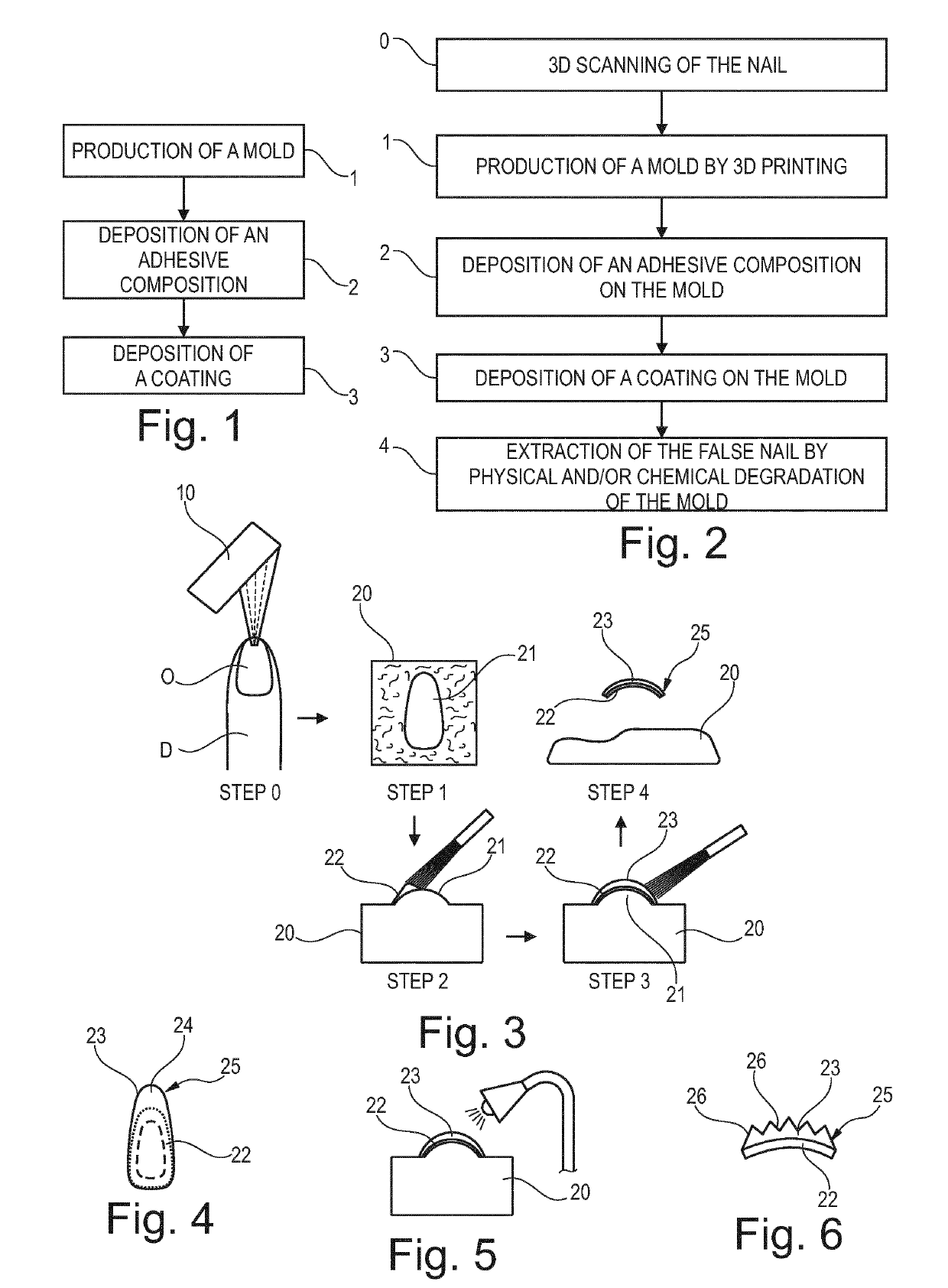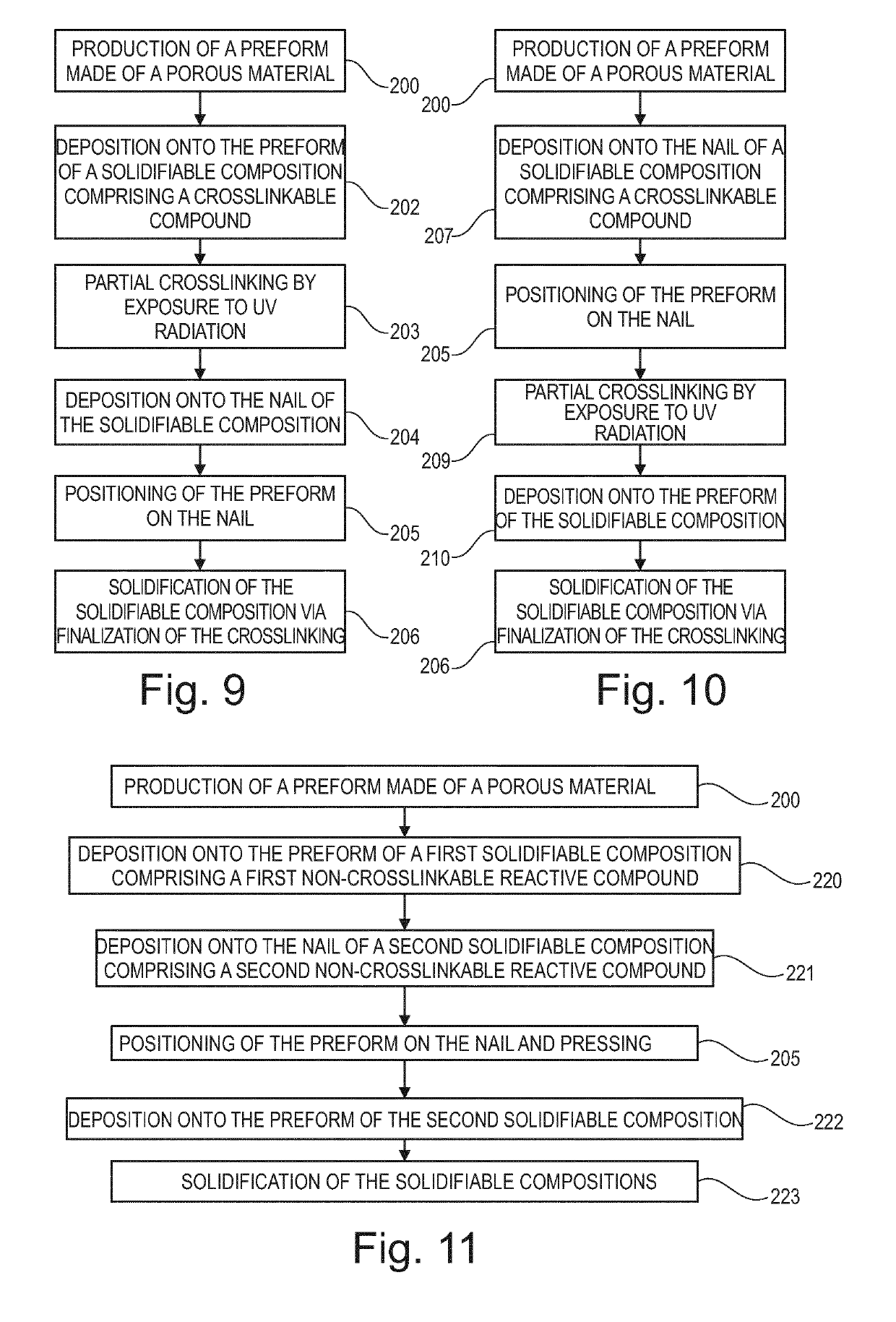Process for manufacturing a false nail
a manufacturing process and nail technology, applied in the field of false nail production, can solve the problems of limiting interest, affecting the longevity of varnish, and not being able to lengthen the nail or unify the length, so as to facilitate physical and/or chemical degradation, limit the damage of the layer, and be easily used for additive manufacturing
- Summary
- Abstract
- Description
- Claims
- Application Information
AI Technical Summary
Benefits of technology
Problems solved by technology
Method used
Image
Examples
example 1
[0436]The end of a person's finger is taken by a 3D scanner. By file data processing, the nail part of the end of the finger is isolated and a 3D file of the surface of the nail is produced. From this 3D file comprising the 3D digital data of the acquisition of the relief of the nail, a “mold” 3D digital object is created.
[0437]The 3D digital data of this “mold” 3D digital object are then used to produce, via a 3D printer, for example the printer sold under the brand name ProJet® 3500 HDMax by the company 3D Systems, a mold made of a first material formed in this example from wax, especially the wax sold under the brand name VisiJet® S300 by the company 3D Systems.
[0438]The adhesive composition is then made with the following mass proportions, relative to the total mass of the composition:[0439]Kraton G1701 5%,[0440]Regalite R1100CG 15%[0441]Kaydol 5%[0442]Isoamyl acetate in quantity sufficient for 100%.
[0443]A layer of this composition is deposited by brush, on the mold, in a mass ...
example 2
[0446]A support is made by 3D printing reproducing five nail molds made of a first material.
[0447]This support is then scanned in 2D and the projected surfaces of the nail parts are extracted, omitting all the surfaces between the nail parts.
[0448]This file is introduced into a printing machine, for example a printer from the company Scodix. Before introducing the mold into the machine, it is spread, using a brush, with a layer of about 100 μm of an adhesive composition having the following formula:[0449]Kraton G1701 5%,[0450]Regalite R1100CG 15%[0451]Kaydol 5%[0452]Isoamyl acetate qs 100%
[0453]The mold thus covered is then placed in the Scodix printer. The Scodix printer is set up, by means of its positioning system. Thus, on the basis of the 2D file, it delivers the photo-polymerizable ink sold under the name PolySENSE® 100 by the company Scodix onto the nail parts of the support.
[0454]The machine is controlled so that it prints, with the photo-polymerizable ink forming the second...
example 3
[0456]A 3D object is made by additive manufacture, using the Visijet S400 equipment sold by the company 3D Systems. The object is a mold and represents a nail.
[0457]A layer of 1 mm of water-based adhesive, known under the brand name Uhu®, is then deposited onto the surface of the mold.
[0458]A coating 500 μm thick is then produced on this coated surface by applying a UV gel known under the brand name CND Shellac Xpress 5 top coat. The whole is placed under a UV lamp for 3 times 1 minute with an interval of one minute between each irradiation. The lamp is known under the brand name CND Shellac 36 W.
[0459]The false nail thus obtained is detached from the mold.
PUM
| Property | Measurement | Unit |
|---|---|---|
| melting point | aaaaa | aaaaa |
| melting point | aaaaa | aaaaa |
| length | aaaaa | aaaaa |
Abstract
Description
Claims
Application Information
 Login to View More
Login to View More - R&D
- Intellectual Property
- Life Sciences
- Materials
- Tech Scout
- Unparalleled Data Quality
- Higher Quality Content
- 60% Fewer Hallucinations
Browse by: Latest US Patents, China's latest patents, Technical Efficacy Thesaurus, Application Domain, Technology Topic, Popular Technical Reports.
© 2025 PatSnap. All rights reserved.Legal|Privacy policy|Modern Slavery Act Transparency Statement|Sitemap|About US| Contact US: help@patsnap.com



